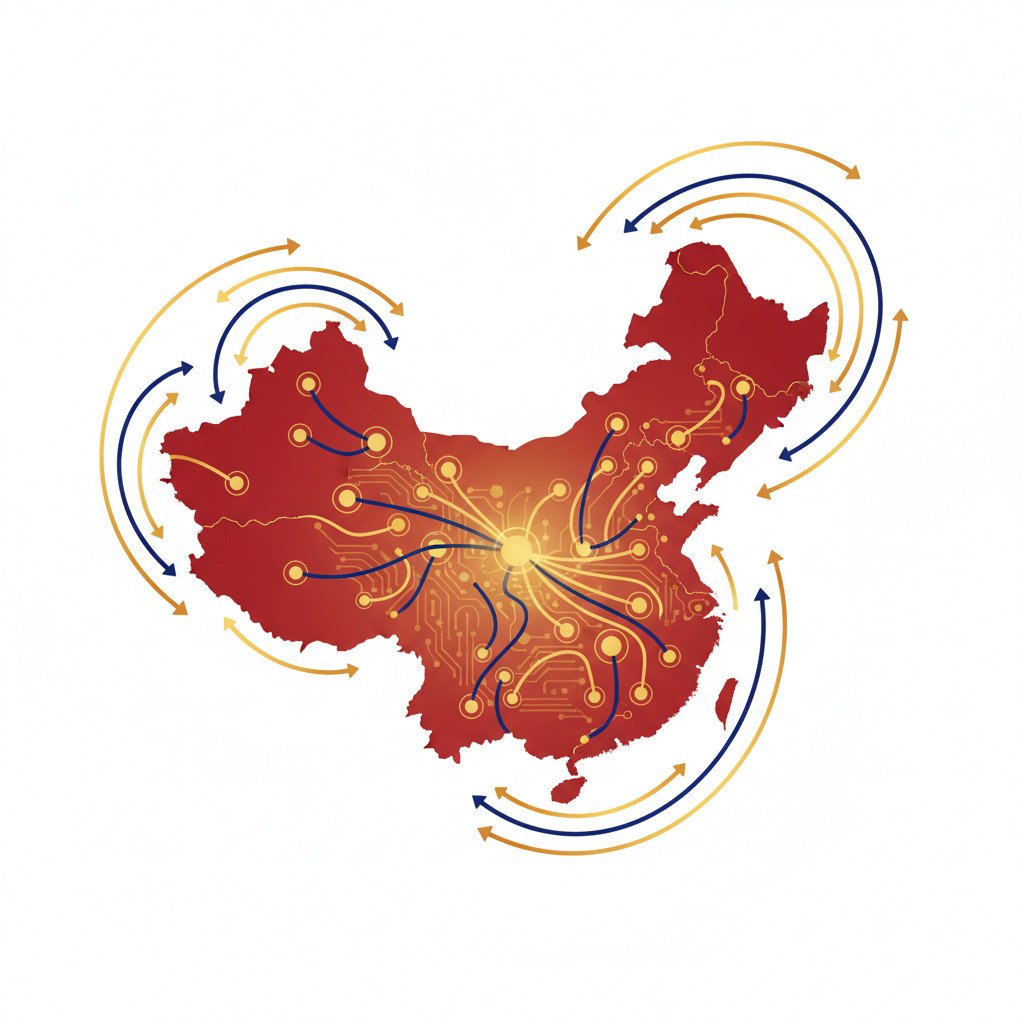Introduction
China AI adoption doubles to 515 million users, according to a mid 2025 CNNIC report. That surge happened in just six months and stunned analysts. It pushed the national adoption rate to 36.5 percent, changing how people live and work. As a result, everyday chat and search now include generative AI for millions.
Domestic models propelled the rise. DeepSeek, Qwen and Doubao exploded in popularity, and over 90 percent of users chose a domestic model first. Meanwhile younger adults drove adoption; 74.6 percent of users are under 40. Also, a large share hold higher education degrees, which shaped demand for advanced features.
Policy and patents gave the trend momentum. Beijing’s AI Plus initiative and a push for self reliance aligned public funds and firms. Therefore China now fields massive talent and 1.576 million AI patent filings globally. In this article we unpack what the numbers mean for markets, products and geopolitics. We explore monetization, regulation and the future of a home grown AI ecosystem.

China AI adoption doubles to 515 million users
The headline captures a dramatic shift in AI growth in China. In six months, the generative AI user base more than doubled, reaching 515 million. As a result, the national adoption rate hit 36.5 percent in the first half of 2025.
Key user statistics and demographic insights
- Total users: 515 million as of June 2025, up 266 million since December 2024. (source: CNNIC via reporting and analysis)
- Adoption rate: 36.5% nationwide, showing rapid technology adoption in China.
- Age skew: 74.6% of users are under 40, indicating youth-led uptake.
- Education: 37.5% have tertiary education, which correlates with advanced feature use.
- Domestic preference: Over 90% chose domestic models like DeepSeek, Qwen, Doubao, fueling local AI ecosystems.
- Patent activity: China filed about 1.576 million AI patent applications by April 2025, roughly 38.6% of global filings.
Technological factors driving adoption
- Local models improved performance and local language support, therefore they fit user needs.
- Infrastructure investments and state support under the AI Plus initiative accelerated deployments.
- Mobile-first services and integration into apps made AI accessible for millions.
- Startups and giants released user-friendly products; for example, DeepSeek’s R1 launch in January 2025 sparked usage growth.
Finally, earlier studies suggested China had 195 to 230 million users in mid 2024, which underscores the scale of recent growth (see reporting).
| Region | User Numbers (approx.) | Percentage Growth (Dec 2024 to Jun 2025, approx.) | Key Industries Driving Adoption |
|---|---|---|---|
| Yangtze River Delta (Shanghai, Jiangsu, Zhejiang) | 125,000,000 | 135% | Tech, finance, e-commerce, cloud services |
| Pearl River Delta (Guangdong, Shenzhen, Guangzhou) | 100,000,000 | 150% | Manufacturing, e-commerce, media, cloud |
| Beijing-Tianjin-Hebei | 65,000,000 | 125% | Government, AI research, finance, enterprise software |
| Chengdu-Chongqing Cluster | 45,000,000 | 160% | Tech hubs, gaming, cloud, education |
| Central and Western Provinces | 75,000,000 | 180% | Manufacturing, logistics, agriculture tech |
| Northeast (Liaoning, Jilin, Heilongjiang) | 35,000,000 | 95% | Heavy industry, government digitization |
| Southwest (Yunnan, Guizhou) | 35,000,000 | 170% | Public services, telecom, regional platforms |
| Northwest (Shaanxi, Xinjiang, Gansu) | 35,000,000 | 130% | Energy, public sector, mining |
Total (approximate): 515,000,000 users
China AI adoption doubles to 515 million users — Business and economic impact
The scale of China AI adoption doubles to 515 million users changes business plans across the country. Companies now face sudden, deep demand for AI features. As a result, product roadmaps accelerate and budgets shift toward AI engineering and cloud capacity.
Domestic firms adapt quickly. Alibaba Cloud, ByteDance and DeepSeek embed models across mobile apps. Therefore commerce, search and social products add generative features to improve engagement and conversions. Meanwhile enterprise software vendors offer fine-tuned industry models for finance and manufacturing.
Global firms cannot ignore the market. Although OpenAI and Google DeepMind remain blocked on the mainland, international suppliers pursue local partnerships and compliant deployments. As a result, multinationals invest in China focused research and joint ventures. For further context on the user surge, see reporting by the South China Morning Post.
Economic effects will compound quickly. Higher adoption boosts productivity and creates new monetization channels. Therefore advertising, content services and enterprise subscriptions become larger revenue pools. The state led AI Plus initiative also directs capital and contracts, which supports startups and large vendors alike. See China Daily coverage of the ecosystem growth.
Key opportunities for companies and investors
- Monetization at scale: subscription tiers, API sales and microtransactions unlock direct user revenue because users now expect AI features.
- Enterprise transformation: banks, logistics and manufacturing adopt tailored models, therefore they cut costs and speed decision cycles.
- Platform expansion: app developers and cloud providers gain share by bundling models and data services into platforms.
- Talent and IP race: with 1.576 million AI related patent filings, firms compete on research, therefore acquisitions and partnerships will accelerate.
In short, the market shift forces both incumbents and startups to retool. Companies that move fast and localize will capture disproportionate value.
Conclusion
China AI adoption doubles to 515 million users, and the shift matters for every stakeholder. The surge moved adoption to 36.5 percent in months. Young, educated users drove uptake, and domestic models captured the market. Policy and heavy R&D investment pushed the ecosystem forward. As a result, China now leads in scale, patents and production of locally optimized models.
Business and public sectors will feel the effects for years. Companies will rewire products and monetization. Investors will chase platform plays and enterprise transformation. Meanwhile regulators and policymakers must balance innovation with governance and safety. Therefore the race will reward those who localize, move quickly and align with policy.
EMP0, a US based AI and automation solutions provider, offers a practical example of how firms can act now. They specialize in sales and marketing automation and deliver ready made, proprietary AI tools. Moreover they deploy comprehensive, AI powered growth systems securely for clients to multiply revenue. Visit EMP0 to learn more.
Finally, the China story shows what rapid, local adoption can achieve. It offers a roadmap for scale, monetization and responsible deployment. The future belongs to teams who combine speed, trust and clear product value.
Frequently Asked Questions (FAQs)
Why did China AI adoption doubles to 515 million users happen so quickly?
Multiple factors combined to drive rapid growth. Domestic models improved language support and user experience. Government programs like AI Plus and heavy infrastructure investment amplified deployments. As a result, mobile apps and platforms integrated AI features across services.
Which industries feel the biggest impact?
Commerce, finance and cloud services lead the shift. Manufacturing and logistics use AI for automation and efficiency. Media, gaming and education also scale personalized content and tools. Therefore sectoral change is broad and deep.
How are companies adapting to surging AI demand?
Firms localize models and partner with domestic providers. They monetize via subscriptions, APIs and embedded features. Meanwhile enterprise customers adopt fine tuned models for specific workflows.
What does this mean for global AI development?
We will see parallel ecosystems and more competition. Patent activity and talent mobility accelerate innovation. However cross border collaboration and standards remain crucial for safety and interoperability.
What should investors and policymakers watch next?
Track user engagement, monetization metrics and patent filings. Monitor regulatory shifts and supply chain constraints. In short, the winners will balance speed, trust and practical product value.

